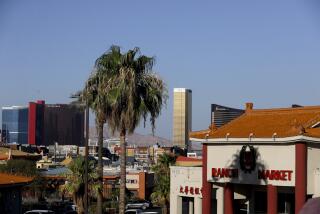Newspapers Help Vancouver’s Chinese Feel at Home : Media: Chinese-language dailies, radio and TV stations flourish, thanks to heavy immigration from Hong Kong and Taiwan.
- Share via
VANCOUVER, Canada — English and French are this country’s official languages, but anyone browsing the shelves of newsstands on its West Coast could be forgiven for thinking that Chinese is too.
Forget the country’s major newspapers and even the venerable Canadian Broadcasting Corp. A surge in immigration from Hong Kong and Taiwan has turned Chinese-language media into a boom industry in Canada.
Nowhere is this explosion more evident than in Vancouver, reputedly the most popular destination in North America for Asian immigrants.
The city boasts three Chinese-language daily newspapers--there are only two in English--and is home to at least nine Chinese magazines, two radio stations and two television outlets.
“The scope is quite incredible,” said Paul Tsang, editor in chief of the newspaper Sing Tao. “The diversity is greater here in Vancouver than you find in Hong Kong, Taiwan and China.”
While mainstream English media have suffered from sluggish advertising revenue and audience figures, Chinese publishers and broadcasters are riding a surge of popularity in Canada.
Because the new wave of immigrants from Asia is heavily weighted to wealthy professionals, it’s a lucrative market and officials in English-language media look wistfully at its success.
Chinese speakers now number about 200,000, or roughly 13% of the Vancouver region’s population, although the proportion is as high as 40% in some areas.
“We would love to do better among the Chinese community,” confesses a spokesman for Southam Inc., which publishes the city’s two English newspapers, the Vancouver Sun and Province.
The biggest local English television station, BCTV, is tapping into the market by broadcasting a Chinese sound feed for its nightly newscast, and Canada’s flagship news magazine, Maclean’s, plans to begin publishing a Chinese edition.
“There’s a lot of scrambling right now. There’s a recognition of the market that is there,” said Asian marketing expert Sonny Wong of Hamazaki Wong Marketing Group.
*
Even though many of the immigrants speak English, they seek out Chinese papers and television for news from home and contact with their culture, media analysts said.
Total circulation for the Chinese press is still short of the 270,000 for the English dailies. But the Chinese dailies burst with advertisements and, at 100 pages and more, are usually far thicker. They also publish seven days a week versus six for the English papers.
The boom was largely pioneered by Sally Aw, chairwoman of Hong Kong-based publisher Sing Tao Holdings Ltd., which started Canada’s first major Chinese daily newspaper.
Sing Tao, which has a daily circulation of about 30,000 in Vancouver, is the biggest Chinese paper and marketing experts estimate it controls about 45% of the market.
From 12 meager pages a day and a staff of six, Sing Tao Daily, which has the same name as the company’s flagship daily in Hong Kong, has grown to an average 92 pages and a staff of 100 in Vancouver since 1983. The company also publishes in Toronto and Calgary and has six other foreign editions.
In Vancouver, the paper covers Canadian and local news, especially topics such as immigration and Canada’s relations with Asia. Along with a weekly magazine, it features articles on social events in the Chinese community and on business, sports and foreign affairs, especially in Hong Kong and Asia.
On a recent visit to celebrate the opening of a $5-million, state-of-the art printing plant in Vancouver, Aw said the familiarity of the Sing Tao name gave the newspaper a natural entree among immigrants from Hong Kong.
“We have found there is a niche for our newspaper. People like to know what is happening back home,” she said.
On a recent day, the paper featured stories given scant attention in the local English press: a new internship program for students to Hong Kong, a visit by a Chinese delegation to Vancouver city hall and expanded service to the city by a Taiwanese airline.
*
Hot on Sing Tao’s heels is Ming Pao Daily News, which began in 1993 and quickly grew in circulation to about 24,000 readers on weekdays, giving it a third of the market.
Published by Hong Kong media group Ming Pao Enterprise Corp. Ltd., it, too, bears the name of its parent newspaper in Hong Kong.
Managing Editor Eric Wong says Ming Pao seeks to cover local news with a twist. Because many of its readers are new immigrants, it gives more background on the mechanics of Canadian politics and focuses on Asian angles.
“The English media lack that perspective. . . . Many immigrants are facing a cultural gap. We play a bridging role,” he said.
Sing Tao and Ming Pao are aimed mostly at immigrants from Hong Kong who speak the Cantonese dialect of Chinese.
The city’s third Chinese daily, World Journal, caters to Mandarin speakers from Taiwan and China and is an offshoot of the Taipei-based newspaper United Daily News.
But the Chinese media war is not just being fought at the newsstand. Two AM radio stations and two TV outlets have sprung up.
Fairchild Television, partly owned by the company behind Hong Kong’s TVB, has attracted 55,000 subscribers for its pay cable service, filled with local and overseas programs.
Chinese drama series, comedies and variety shows are a big hit with new immigrants, who make up about half the network’s audience, Fairchild President Joe Chan said.
“These are the programs they used to watch in Hong Kong or Taiwan. . . . It helps ease their homesickness,” he said.
More to Read
Sign up for Essential California
The most important California stories and recommendations in your inbox every morning.
You may occasionally receive promotional content from the Los Angeles Times.









